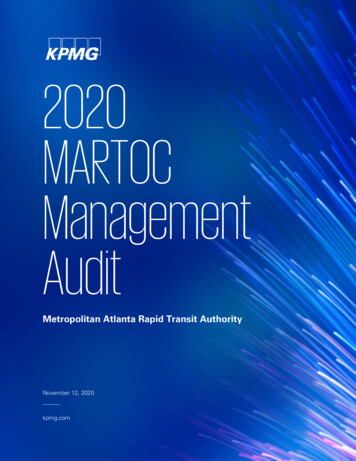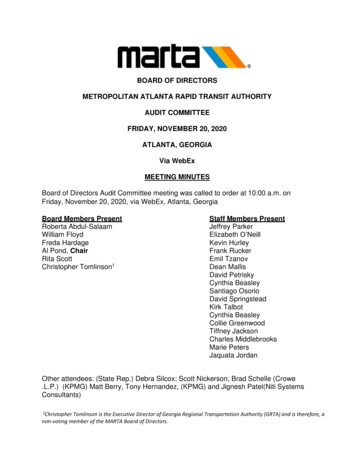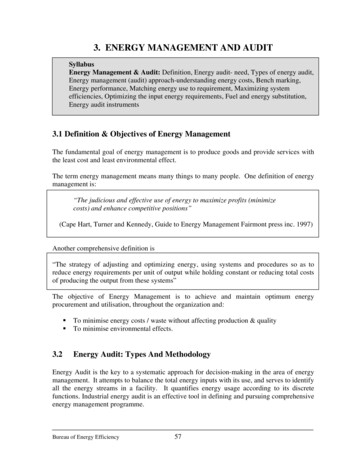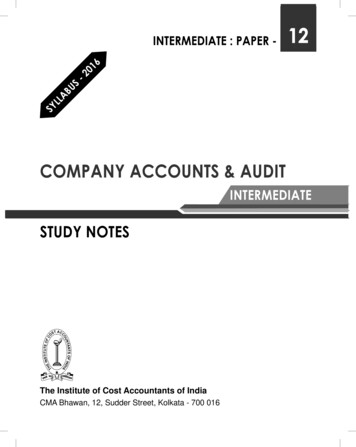
Transcription
2020MARTOCManagementAuditMetropolitan Atlanta Rapid Transit AuthorityNovember 12, 2020kpmg.com
ContentsIntroduction and Executive Summary . 31.General Observations . 202.Rail Operations . 243.Bus Operations . 294.Mobility Operations . 345.Capital Projects . 386.Information Technology and Information Security . 427.Human Resources . 518.Finance . 569.Procurement . 6010.Customer Service . 64 2020 KPMG LLP, a Delaware limited liability partnership and a member firm of the KPMG global organization of independent member firms affiliated with KPMGInternational Limited, a private English company limited by guarantee. All rights reserved. NDP117682The KPMG name and logo are trademarks used under license by the independent member firms of the KPMG global organization.
Introduction andExecutive SummaryBackground and ObjectivesThe Metropolitan Atlanta Rapid Transit Authority (“MARTA” or “the Authority”) engaged KPMG LLP(KPMG) to conduct a management audit for Fiscal Year 2020 (FY20). This report satisfies the requirementin MARTA’s enabling legislation (The MARTA Act) to conduct a management audit on a quadrennial basisand deliver the report to the Metropolitan Atlanta Rapid Transit Overview Committee (MARTOC). Theobjective of the FY2020 MARTOC Management Audit was to conduct an assessment of the followingkey functions across the Authority:— Rail Operations— Human Resources— Bus Operations— Finance— Mobility Operations— Procurement— Capital Projects— Customer Service— Information Technology and InformationSecurityScope and MethodologyKPMG and MARTA agreed to a specific scope to focus tasks across each of the desired functional areas.Activities KPMG performed across each functional area include:Functional AreasRail OperationsRail Car Maintenance,Maintenance of Way,VerticalTransportation,Facilities ManagementTasks— Determine the existence and effectiveness of policies and proceduresto help ensure MARTA’s compliance with the MARTA Act andapplicable Federal Transit Administration (FTA) and GDOT regulationsand requirements, and the achievement of MARTA’s organizationalobjectives.— Evaluate how the Rail Operations Department monitors itsperformance and effectiveness.2020 MARTOC Management Audit–3–
Functional AreasBus OperationsBus MaintenanceTasks— Determine the existence and effectiveness of policies and proceduresto help ensure MARTA’s compliance with the MARTA Act andapplicable FTA and GDOT regulations and requirements, and theachievement of MARTA’s organizational objectives.— Evaluate how the Bus Operations Department monitors itsperformance and effectiveness.Mobility OperationsOperationalPerformance— Determine the existence and effectiveness of policies and proceduresto help ensure MARTA’s compliance with the MARTA Act andapplicable FTA and GDOT regulations and requirements, and theachievement of MARTA’s organizational objectives.— Evaluate how the Mobility Department monitors its performance andeffectiveness.Capital ProjectsPlanning andBudgeting, Fundingand Financing, CapitalProcurement— Review relevant policies and procedures for existence and quality anddetermine if adequate internal controls are in place for the effective andefficient planning, budgeting and procurement of capital projects.InformationTechnology andInformation SecurityOracle Utilization,Information SecurityPolicy & Procedures— Assess the extent of Oracle utilization within MARTA.— Assess how the performance of capital projects is monitored andevaluated.— Review policies and procedures related to information security withinthe IT Department and the Information Security Department forexistence and quality and determine if adequate internal controls overinformation security are in place within the IT Department and theInformation Security Department.— Evaluate how the IT and Information Security Departments monitortheir performance and effectiveness.Human ResourcesEmployeeAdministrationFinancePayroll— Review policies and procedures related to employee administration forexistence and quality.— Evaluate the effective use of information technology in the employeeadministration process.— Review policies and procedures related to employee payroll forexistence and quality.— Assess the efficiency and accuracy of the payroll process.ProcurementLifecycle, InventoryCustomer ServiceCustomer CareCenter, Public Safety— Evaluate the efficiency of the procurement process lifecycle.— Assess the effectiveness and efficiency of the inventory assetmanagement process.— Review policies and procedures of the Customer Service Departmentfor existence and quality and determine if adequate internal controlsare in place within the Customer Service Call Center.2020 MARTOC Management Audit–4–
KPMG’s approach consisted of three phases and was based on our public sector experience and KPMG’sreputation for providing quality service. To this foundation, we added effective project planning, criticalinformation gathering and thoughtful analysis, necessary validation and valuable reporting skills.Phase 1 – Project Planning and KickoffDuring Phase 1, KPMG met with key project stakeholders to reaffirm project goals, milestones andobjectives. The meeting included discussions about data needs, interview list, project schedule, androles and responsibilities of the KPMG team and MARTA staff. KPMG confirmed that planned taskswere “sized” in a manner that could be completed within the requested time frame and allowed KPMGto meet overall project objectives, including identification of key in-scope processes/procedures forreview within each in-scope area.Phase 2 – Information Gathering and AnalysisDuring Phase 2, KPMG focused on reviewing existing information and interviewing MARTA personnel tounderstand the strengths and opportunities within the in-scope functions and process areas. Wegathered an understanding of current process objectives and applicable governance and compared tocurrent operations. This activity helped us to identify and highlight areas of risk and non-value-addedactivities. Processes were understood conceptually and followed in operation to identify possible controlgaps and weaknesses. Our analysis aimed to determine the economy, efficiency, effectiveness, andpotential related risks of the current related processes.While assessing the business processes, KPMG focused on the following process elements andobjectives:— Efficiency;— Effectiveness;— Duplication of efforts;— Compliance;— Controls Weaknesses and Gaps; and— Inputs and Outputs.To complete these tasks, KPMG performed the following activities as part of Phase 2:— Requested and Reviewed Existing Documentation – This information was reviewed by ourproject team and used in subsequent analyses, as appropriate. This involved collecting primarilythe following data:oCurrent and historical versions of the MARTA Act;oRelevant governing regulations, policies, and procedures;oPolicy and procedure manuals and other similar documentation;oPlanning and budget documents;oCurrent and previous Comprehensive Annual Financial Reports;oOrganization unit and program descriptions;oStaff information;oManagement and financial reports;oOperating and performance data;oCapital, maintenance and repair data;2020 MARTOC Management Audit–5–
oCopies of prior management audits, performance reviews, and studies, includingFederal and Georgia Department of Transportation documents;oInventory of information systems hardware and software;oMARTA International Organization for Standardization (ISO) Certifications, includingISO 55001 (asset management);o23 CFR Part 515 Transit Asset Management (TAM) Plans and associated TAMperformance measures and targets (e.g., useful life benchmarks for rolling stock andequipment, condition ratings for facilities, speed restrictions on track, etc.);oApplicable National Transit Database (NTD) benchmarks for MARTA and identifiedpeer and aspirational agencies; andoCurrent workflow process diagrams.— Conduct Interviews – KPMG conducted interviews with key MARTA management and variousother MARTA staff. During Phase 1, KPMG developed an interview request list to establish anappropriately sized list of interview subjects across the in-scope functional areas. Interviewresults were evaluated to identify potential issues, as well as to help focus subsequent factfinding and analysis efforts by the project team.— Perform Observations – To further substantiate what we learn from our information analysisand interviews, KPMG observed documentation of certain aspects of various processes. Weaimed to learn and verify how processes and functions actually are occurring – not just how theyare supposed to occur. Observations were conducted remotely due to the COVID-19 pandemic.KPMG reviewed in-scope policies, procedures, and processes against leading practice and forcompleteness, weaknesses, gaps in efficiency and controls.— Develop Findings and Recommendations – As a result of the data gathering and assessmenttask, findings, observations, and recommendations were developed. Where appropriate, wedeveloped meaningful, actionable recommendations connected with our findings/observationsfor MARTA consideration. We focused on the following objectives:oImprove PerformanceoContain CostsoImprove Efficiency of RevenuesoReduce RisksoFacilitate Decision MakingoContribute to Public AccountabilityPhase 3 Reporting and RecommendationsDuring Phase 3, KPMG finalized a draft report that summarizes the current state environment andrecommendations for improvement. The recommendations developed are designed to enhanceoperations, performance, and mitigate current and future risks. KPMG presented the draft report toMARTA leadership. MARTA responded with formal complete written feedback, which KPMG consideredprior to the issuance of the final report.MARTA fully cooperated with the audit and allowed access to all its books, records, and documents tothe extent that KPMG deemed necessary.2020 MARTOC Management Audit–6–
Executive SummaryThe following table provides a succinct summary of the observations and recommendations contained inthe full report. KPMG has provided priorities for each recommendation based on assessing a number offactors, including degree of impact, return on investment, and the risk/opportunity presented by theobservation, and timeframe required to implement the recommendation.High Priority RecommendationsObservation 1.A: Insufficient Enterprise-Wide Policy and Procedure Review and Approval ProcessesObservation: MARTA lacks a structured and effective method to update and approve policies and proceduresin a timely manner and review on a regular basis. This increases the risk that as processes and/or regulationschange, policies and procedures are not reviewed, updated and approved to reflect those changes. As aresult, employees may not have access to or knowledge of updated processes, posing the risk thatemployees will not perform required functions properly.Recommendation: MARTA should develop a structured process to review and update policies andprocedures, including a defined approval matrix and a timely cadence (i.e. annually). In addition, MARTAshould hold individuals accountable for not updating or approving procedures in accordance with thedeveloped policy.MARTA Response: MARTA has in the past maintained a centralized approach to circulating, reviewing andapproving policies and procedures. In addition, the organization has successfully advanced the developmentof Safety and Security policies and procedures as well as the development of the newly-revised EmployeeHandbook, which we are getting ready to be released. We are continuously evolving and improving ourprocesses and intend to further streamline our approach to the review and approval process. Currently we areassessing the opportunity to re-establish this centralized function in the Chief of Administration Department.Observation 1.B: Opportunity for Performance Management StrategyObservation: MARTA leverages various tools for its enterprise data management platform. The Oracle ERP isbundled with Oracle Business Intelligent Enterprise Edition (OBIEE), which is a powerful data managementand analytics tool. However, MARTA utilizes OBIEE in a limited capacity. Microsoft PowerBI appears to beMARTA’s preferred data management platform – which is used for KPI reporting and various reportgeneration. Inconsistent utilization and lack of integration across critical data sources limits the effectivenessand value of the information presented in reports and dashboards.Recommendation: MARTA should perform an assessment of the feasibility and potential benefits of a singlefully integrated data management and analytics platform to avoid wasteful duplication of effort in twosystems and allow access to reporting information from critical systems in a single source. MARTA shoulddevelop a formal data management strategy based on the outputs of the assessment.2020 MARTOC Management Audit–7–
MARTA Response: In 2019, MARTA strategically identified the need to make better data-driven decisions toimprove service and increase operational efficiency, and the Office of Research and Analysis was tasked bysenior management to build on MARTA’s existing performance management strategy to increasetransparency, ownership, and accountability for performance throughout the Authority. The Office ofResearch and Analysis has acted to develop a clear, consistent, data-driven methodology for setting KPItargets; initiated discussions with KPI owners to revise and streamline MARTA’s current strategic KPIs andmake them more customer focused; and is co-leading a multi-disciplinary team (the Dashboard Development,Deployment, and Utilization Team) to work with each department to: (1) Define KPIs and set targets that alignwith and support the Authority’s strategic goals; (2) automate, to the extent possible, the data sources,systems, and business processes for KPI tracking; (3) develop and deploy dashboards for KPI reporting; and(4) promote a culture of utilizing dashboards as an integral part of the decision-making process.Observation 1.C: Lack of Data Integration StrategyObservation: MARTA’s current data processing and management efforts are fragmented. The IT team hasdeveloped useful dashboards and KPI reporting tools for various departments. However, these efforts aresiloed and tailored for the individual departments and their functional needs.Recommendation: MARTA should formulate an enterprise-wide data integration, management andprocessing strategy to integrate data from multiple disparate systems. This Enterprise Data Warehousing(EDW) solution can provide MARTA with better insight into their integrated data as well as better analytics.MARTA Response: MARTA has initiated a concerted and disciplined effort driven by the Research andAnalysis Department to re-establish its Key Performance Indicators (KPIs) with a standardized methodologyand consistent approach across the organization. To support this effort, the IT Department established anEnterprise Data Warehousing and Management team in 2019 with a focus on integrating Oracle and othersystems of record to provide better insights and access to information regardless of the source application.This team has put in place and is consistently supporting Power BI and the OBIEE Oracle tools as primarydata management tools. There are other standard tools that are actively being utilized to clean and producedata. In addition, MARTA purchased and implemented in 1999 Emvison360 as a centralized documentmanagement tool which largely houses all electronic documents (program plans, emergency managementplans, blue prints and drawings, policies and procedures, etc.) for the organization as a whole. All of thesetools combined are currently meeting our organizational needs. MARTA has not identified a critical or pressingneed to adopt an Enterprise Data Management Warehouse platform. That said, we have IT teams entirelydedicated to support the data management functions and needs, and we have the corresponding Researchand Analysis teams dedicated to the KPIs efforts which are successfully advancing. As these efforts mature,and we continue to expand our analytics capabilities we might consider a more robust or different approach todata integration, but at the moment this integration is being achieved through alternative means.Observation 5.A: Lack of Consistent Capital Program ProceduresObservation: A 2017 internal review identified gaps in capital program management structures andprocesses, including a lack of documented SOPs to support effective and consistent project/programmanagement across the Authority. Capital program SOPs have not yet been developed. MARTA is inprogress on an initiative to deploy procedures for a centralized program management office by the end ofCalendar Year 2020.Recommendation: MARTA should continue to prioritize the development, approval, and deployment ofprocedures to support effective and consistent planning, budgeting, monitoring, and procurement of capitalprojects.2020 MARTOC Management Audit–8–
MARTA Response: Agree. MARTA has made significant strides in establishing a defined process for putting;in place centralized, uniformed, cross-functional and accessible procedures. It started with the developmentof a Governance process which defines approval authority and other defined requirements for projectmanagers. Using the Governance document as a baseline, procedures are being written and staffed for useby project managers regardless of what department they reside in. These procedures will affect projectmanagement, construction management, budgeting, cost control, schedule management, and supportfunction interface with Safety and Quality, Grants, and Procurement. Our milestone goal remains the end ofCalendar Year 2020 to get procedures in place with robust training beginning in January 2021.Observation 5.B: Lack of Capital Project Reporting IntegrationObservation: Capital project data management has historically been decentralized and compiled by projectportfolio managers across the Authority. Critical cost, schedule, and milestone data is manually tracked andreported for compilation by the Department of Capital Programs, Expansion, and Innovation. MARTA is in theprocess of rolling out Oracle Unifier functionality which will help integrate this critical data.Recommendation: MARTA should continue to prioritize the Unifier implementation and develop robustprocesses and training materials to help enable consistent capital program data integration for monitoring andreporting.MARTA Response: Agree. MARTA has embarked on an aggressive program through the use of OracleUnifier to define and manage all elements of project delivery and cost management. Phase 1 of the OracleUnifier implementation is complete. Phase 1 included replacing SharePoint for Project Charters and ProjectCharter Requests with supporting workflows and replacing Microsoft Access for Capital Reports. Costmodules are active in Unifier all of the Oracle Financials (e-business suite) data already populated in thesystem. Phase 2 will include Project delivery modules specific to program and construction management andsupporting workflows as part of procedures development. As these workflows are completed, MARTA willintegrate them into Unifier. A fully integrated and functional data management system will allow MARTA togenerate reports, track key performance indicators, develop and track budgets, and train project managers onprocedures and data management. A subset of rolling out Unifier is to have a procedures manual as well astraining manuals. Our milestone goal is March 2021 to be fully integrated and functional.Observation 6.A: Oracle Process Improvement OpportunityObservation: MARTA is working with Oracle to upgrade the software to version 19g, which is scheduled tofinish by January 2021. This upgrade provides an opportunity for MARTA to perform a comprehensive reviewof the processes and explore opportunities to automate many manual processes. The IT team has beenworking with various functional groups to review and update processes, workflows and functionality of Oraclesystems to fix known issues and improve system effectiveness.Recommendation: As MARTA completes its planned Oracle upgrade, MARTA should undertake acomprehensive exercise to review, update and document business processes associated with the upgradedOracle ERP for all MARTA user departments and business units. This comprehensive review shouldemphasize identifying, designing and implementing process enhancements/automation and systemconfigurations to process efficiency and promoting greater enterprise-wide adoption of available Oracletechnology.2020 MARTOC Management Audit–9–
MARTA Response: MARTA has recently undertaken two efforts to help address this opportunity; Thecreation of a business process review task force (as part of a larger effort to optimize our annual budget) anda Business Relationship Manager role to assist departments with better utilizing MARTA’s technologyportfolio of solutions.In the past 2 years, MARTA recognized the lack of business process engineering skills in the agency to assistin business adaptation to Oracle and other system implementations. Consequently, in FY2020, theTechnology department created a new role (Business Relationship Manager) within the office of Innovationand Research to work with departments to understand their business processes, match the resultingautomation needs with the agency’s technology portfolio, and to assist the departments with adapting theirbusiness processes to take full advantage of the available solutions.Our department hired our first two Business Process Managers and they began work in October of 2020.MARTA will utilize these positions (in coordination with the business process review task force) to helpstreamline how each department works with our technology and to continually identify opportunities forimprovement.Observation 6.B: Oracle Integration with other Enterprise SystemsObservation: Oracle provides a robust set of Application Programming Interfaces (APIs) for most commonintegration needs. MARTA has invested significantly into various standalone systems that provide betterfunctional values for MARTA specific needs, such as Hyperion for budgeting, Saba for training management,Clearwater for Investment Accounting and others.While MARTA has largely integrated Oracle with many systems for various functionality, some enterprisesystems such as Clearwater, Unifier, OLIS, Hyperion, P6 are not fully integrated with Oracle. This lack ofintegration contributes to cumbersome manual processes that are more at risk for errors.Recommendation: As part of the comprehensive review recommended above, MARTA should review theintegration need for Oracle ERP with various in-house enterprise systems. Some of the existing integrationprocesses are rudimentary (data dump, FTP, Excel etc.), which needs to be automated with the use of APIs.MARTA Response: As a by-product of the North Highland HR assessment, several system integrations wererecommended by the team and the Application Support group within the Technology department is beginningthe process to sequence and resource plan for those efforts (in time for the FY2022 budget planning cycle).In addition, the newly staffed Business Relationship Managers will be working with each business unit overthe next 6 months to prioritize and sequence needed integrations for inclusion in the FY2022 budget planningcycle. These 2 processes will yield a plan and the resources to integrate those parts of the technologyportfolio the merit automation.Observation 9.A: Manual Procurement and Contract Management ProcessesObservation: MARTA uses a combination of automated and manual processes to execute key procurementand contract management processes. These processes contribute to extended procurement lifecycle timesand may not represent an efficient deployment of procurement resources.Recommendation: MARTA should conduct an in-depth analysis into its procurement and contractmanagement processes to identify and implement opportunities to streamline and automate theseprocesses. Emphasis should be given to opportunities to optimize MARTA’s utilization of existing, enhanced,or new Oracle solutions.2020 MARTOC Management Audit– 10 –
MARTA Response: CPM is currently in discussion with Information Technology to evaluate and deploy acontract management system as well as developing processes for the functionality of a new contractmanagement system.Observation 9.B: Lack of Oracle Contract Management FunctionalityObservation: MARTA does not leverage Oracle functionality to effectively manage contracts. CPM uses“shadow” Excel spreadsheets to manually enter spend data from Oracle and track contract balanceinformation, increasing process time throughout the procurement and contract administration lifecycles,increasing the risk of errors through manual tracking, and reducing visibility into critical procurement andcontract management data.Recommendation: MARTA should evaluate deploying Oracle contract management functionality anddeveloping processes to effectively leverage this functionality.MARTA Response: CPM is currently in discussion with Information Technology to evaluate and deploy acontract management system as well as developing processes for the functionality of a new contractmanagement system.Medium Priority RecommendationsObservation 2.B: Rail Operations KPIs in Alignment with Industry StandardsObservation: Rail Operations maintains and publicly reports KPIs that align with industry standards for publictransit organizations. Additional internal performance monitoring practices and metrics are in place throughoutthe Division of Rail Operations to provide actionable information to management and promote performanceaccountability.Recommendation: While Rail Operations maintains industry standard performance metrics, anddemonstrates adherence to or exceedance of metric targets, MARTA should consider additional, the inclusionof more customer-centric metrics into formal KPI reporting. This is an emerging trend among leading NorthAmerican transit and rail agencies. Example metrics for consideration include customer journey timeperformance, additional platform time, and additional train time. The traditional methodology, and AmericanPublic Transportation Association (APTA) standard, for measuring OTP is from terminal to terminal (i.e., startto end of a line). This OTP metric has specific shortcomings, particularly since many customers are not ridinglines from terminal to terminal and many also transfer. Generally, customers perceive service delays in termsof additional wait time on the platform or on a train, not based on terminal to terminal OTP.MARTA should also benchmark against peers to regularly calibrate its target metrics.2020 MARTOC Management Audit– 11 –
MARTA Response: MARTA agrees with clarification. The outward Customer Facing KPI that is referenced,OTP, is a lagging indicator of terminal point to terminal point overall schedule adherence. This is a commonand accepted KPI within the industry and MARTA agrees it has limited utility to the Customer. Additional waittime on the platform and on trains are also lagging indicators that report outcomes. MARTA has and willcontinue to focus on leading indicators or drivers of performance in addition to the more common laggingindicators. This includes operator and fleet availability, fleet reliability, right of way system performance (trackcircuit, signals, switch performance, power and track conditions), audio and visual information system (AVIS)and elevator reliability and elevator down time. MARTA has also realigned their Rail & Station Managementresources to be more focused on the Customer with more direct leadership over rail lines on the systemmanaging the service. MARTA is leveraging their resources in both the Rail Service Control Center (RSCC)and Maintenance Control Center (MCC) to track, trend and assess service calls, service delays andpreventable incidents to reduce and/or limit service impacts. This also includes patron behavior that impactsperformance. On a case by case basis these indicators will be considered for external consumption.Observation 2.C: Potential PowerBI Dashboard Enhancements for Rail OperationsObservation: While Rail Operations leverages PowerBI to generate dashboards to provide insights intosystem performance, existing dashboards largely align directly with MARTA’s formal KPIs. MARTA maybenefit from enhancements to its dashboard reporting to provide insights into more strategic and tactical dataelements.Recommendation: MARTA should develop enterpr
MARTA leverages various tools for its enterprise data management platform. The Oracle ERP is bundled with Oracle Business Intelligent Enterprise Edition (OBIEE), which is a powerful data management and analytics tool. However, MARTA utilizes OBIEE in a limited capacity. Microsoft PowerBI appears to be










